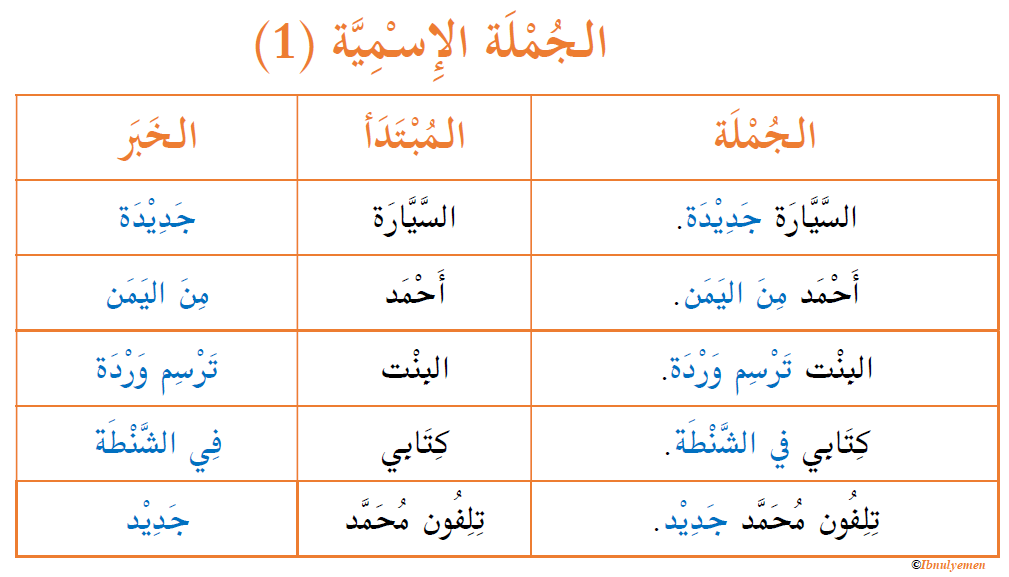Basic Sentence Structure in Arabic (II) Posted by Ibnulyemen اِبْنُ اليَمَن on Nov 9, 2017 in Grammar, Vocabulary
In an earlier post, I focused on one type of Arabic sentences, the verbal sentence الجُمْلَة الفِعْلِيَّة. As its name suggests, it is the sentence that starts with a verb فِعْل. In like manner, the nominal sentence الجُمْلَة الإِسْمِيَّة, our focus in this post, is the sentence that starts with a noun اِسْم. This type has two parts: the subject (or topic) المُبْتَدأ and the predicate الخَبَر.

The subject (topic) المُبْتَدأ:
المُبْتَدَأ literally means ‘anything that we start with’. In structuring a sentence, it must be a noun. Plus, it must be a definite noun, i.e. مَعْرِفَة. If not, it would not make a sentence. As elaborated on in an earlier post, the definite noun, the subject مُبْتَدَأ, can be one of three types of definite nouns, as in (A).
(A)
| (definite because of الـ) | ‘the dog’ | الكَلْب |
| (definite because of iDHaafah to a definite noun) | ‘the man’s dog’ | كَلْبُ الرَّجُل |
| (definite because of iDHaafah to a pronoun) | ‘our dog’ | كَلْبُنَا |
The predicate الخَبَر:
الخَبَر literally means ‘anything that we tell about someone or something.’ As a part of the nominal sentence, it can be one of three types: a noun/adjective, a semi-sentence (i.e. a prepositional phrase), or a verbal sentence. If it is a noun/adjective, it must be indefinite, i.e. نَكِرَة. If not, it would not make sentence. A semi-sentence is called شِبْه جُمْلَة in Arabic. It is basically a preposition followed by a noun, that is a prepositional phrase. A verbal sentence is a verb (in the present or past) followed by a subject and an object (which can be optional), as in (B).
(B)
مُزْعِج ‘annoying’
فِي البَبْتَ ‘ in the house’
يُزْعِج الجِيْرَان. ‘annoys the neighbors.’
Forming a Nominal Sentence:
As indicated, we must start with the subject (topic) مُبْتَدَأ and then follow it with the predicate الخَبَر. Putting the phrases in (A) and (B) together, we form completely meaningful nominal sentences, as follows:
الكَلْب مُزْعِج. كَلْب الرَّجُل مُزْعِج. كَلْبُنَا مُزْعِج.
الكَلْب فِي البَيْت. كَلْب الرَّجُل فِي البَيْت. كَلْبُنا فِي البَيْت.
الكَلْب يُزْعِج الجِيْرَان. كَلْبُ الرَّجُل يُزْعِج الجِيْرَان. كَلْبُنَا يُزْعِج الجِيْرَان.
To elaborate further, looking at the table image above, you can see that every subject المُبْتَدَأ is definite. السَّيَّارَة and البِنْت are definite due to الـ, أَحْمَد is definite because it is a proper noun, كِتَاب in كِتَابِي is definite because a pronoun is appended to it, and تِلِفُون is definite because it is added to a definite noun, that is مُحَمَّد.
Looking the same table, you can see that every predicate belongs to one of three types. جَدِيْدة and جَدِيْد are indefinite adjectives (i.e. they don’t have الـ). مِنَ اليَمَن and فِي الشَّنْطَة are شِبْه جُمْلَة, i.e. prepositional phrases, and تَرْسُم وَرْدَة is a verbal sentence.
What if:
If the subject المُبْتَدَأ is not a definite noun, the formed sentence is not a sentence; rather, it is a phrase, as in these examples:
| Sentence | Phrase | ||
| الكَلْب مُزْعِج. | ‘the dog is annoying.’ | كَلْب مُزْعِج | ‘an annoying dog’ |
| السَّيَّارَة جَدِيْدَة. | ‘the car is new.’ | سَيَّارَة جَدِيْدَة | ‘a new car’ |
| تِلِفُون مَحمَّد جَدِيْد. | ‘Mohamad’s phone is new.’ | تِلِفُون جَدِيْد | ‘a new phone’ |
Likewise, if the predicate الخَبَر is not an indefinite noun/adjective, it makes a phrase instead of a sentence, as in these examples:
| Sentence | Phrase | ||
| الكَلْب مُزْعِج. | ‘the dog is annoying.’ | الكَلْب المُزْعِج | ‘the annoying dog’ |
| السَّيَّارَة جَدِيْدَة. | ‘the car is new.’ | السَيَّارَة الجَدِيْدَة | ‘the new car’ |
| تِلِفُون مَحمَّد جَدِيْد. | ‘Mohamad’s phone is new.’ | تِلِفُون مُحَمَّد الجَدِيْد | ‘Mohamad’s new phone’ |
What else:
In forming a basic nominal sentence, the subject المُبْتَدَأ and the predicate الخَبَر must agree in gender and number, as in these examples:
| Sentence | Gender | Number |
| الكَلْب مُزْعِج. | masculine | singular |
| الكَلْبة مُزْعِجَـة. | feminine | singular |
| الكَلْبـان مُزْعِجـَان. | masculine | dual |
| الكَلْبتان مُزْعِجَـتان. | feminine | dual |

Build vocabulary, practice pronunciation, and more with Transparent Language Online. Available anytime, anywhere, on any device.




Comments:
Ghani Senik:
I like your explainations…precise and very clear. Thanks alot.
Nina:
This is great! Thank you. It’s is perfectly explained and illustrated, something my teachers failed at. Shukran!
Ibnulyemen:
@Nina You’re welcome! I am glad this fills in the gab that you have in the course of your Arabic learning.